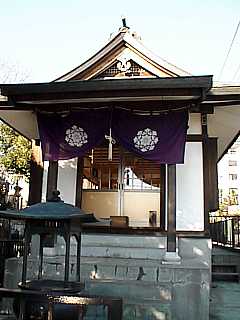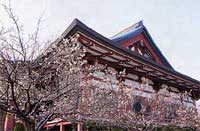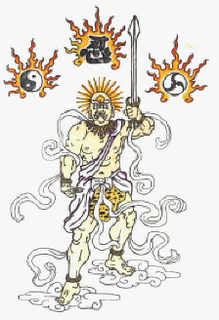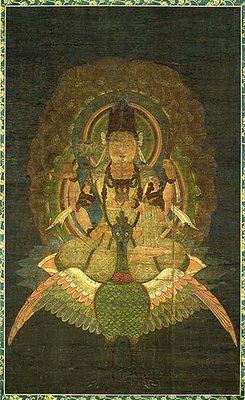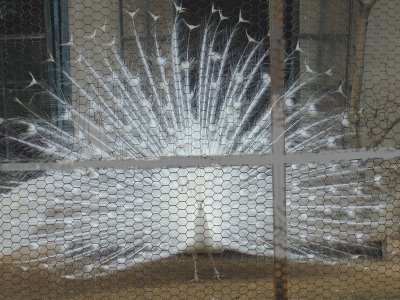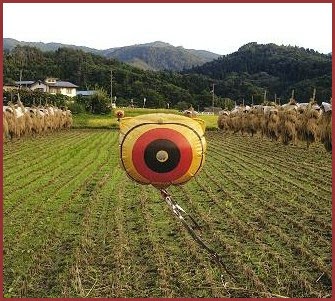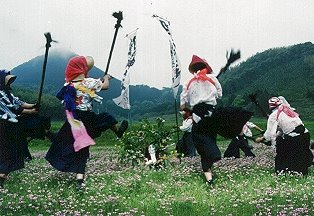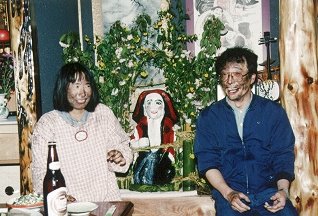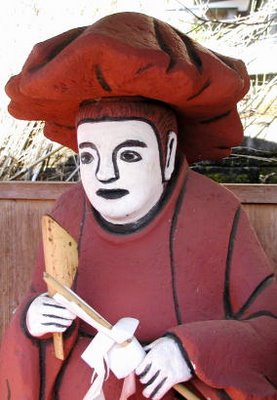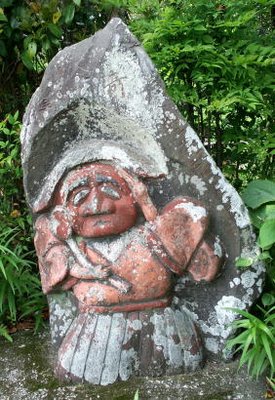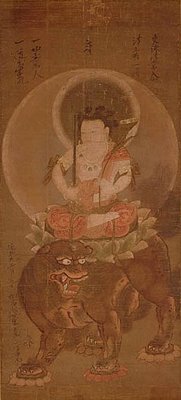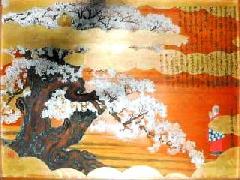:::::::::::::::::::::::::::::::::::::::::::::::::::::::::::::::::::::::::::::::::::::::::::::::::::::
Stone Carvings and Sculptures
Magaibutsu 磨崖仏
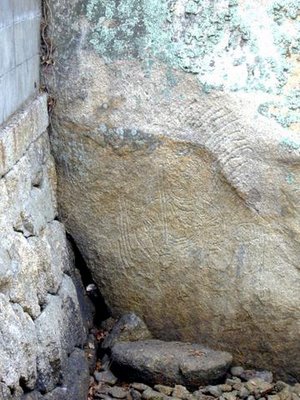
I found this carving of Fudo Myo-O on Shiraishi Island in the harbour, at a very low level close to the beach.
白石島の磨崖仏(不動明王)
フェリー乗り場のすぐ近くにあります。
Buddhist figures chiseled out of stone, the Magaibutsu of Japan.
They follow in the tradition of the greate figures along the Silk Road, from the un-famous reliefs of Bamiyan in Afganistan to Dunhuang and others in China.
Magaibutsu can be found all over Japan, but maybe the most famous are in Kunisaki in Kyushu.
Read the LINKs given below for more.
:::::::::::::::::::::::::::::::::::::::::::::::::::::::::::::::::::::::::::::::::::::::::::::::::::::
More about the Henro Pilgrimage of Shiraishi
and my STONE links is here:
The Shiraishi Pilgrimage to the 88 Temples of Shikoku
. Magaibutsu from the Kibi Region of Okayama
Bunei Sekibutsu 文英様石仏 Stone Buddhas of the Bunei style .
吉備の文英様石仏
:::::::::::::::::::::::::::::::::::::::::::::::::::::::::::::::::::::::::::::::::::::::::::::::::::::::
- quote -
magaibutsu 磨崖仏 Also written 摩崖仏. Ch: moyafo.
Also known as magai sekibutsu 磨崖石仏 or 摩崖石仏. A Buddhist image carved into the surface of natural rock such as a cliff face, a large rock, or a stone cave. The rock-face was first polished, and then the image was created with engraved lines *senkoku 線刻 in low relief *ukibori 浮彫 or in high relief takanikubori 高肉彫. Clay was used to model details on the relief carving. Occasionally colors and gold leaf were applied. The surrounding rock was often hollowed out to form an alcove for the figure, so a deeply carved magaibutsu was sometimes known as *butsugan 仏龕, meaning Buddha alcove and a cave temple large enough for people to enter was often referred to as sekkutsu jiin 石窟寺院 or sekkutsuji 石窟寺.
Rock carving flourished in the Han, and Northern and Southern dynasties in China as well as in India, Afghanistan, and Korea.
In Japan magaibutsu never formed the mainstream of Buddhist sculpture, but there are many surviving examples dating from the 7c to 14c. It has been pointed out that popular belief in the living spirit of rocks in Japan was combined with Buddhism and was expressed in magaibutsu. Examples can be found across the country, but Kyuushuu 九州 has the greatest concentration of rock carvings, including the famous stone Buddhas in Usuki 臼杵, Ooita prefecture (11-12c). The images were carved on soft rock such as tuff, a rock formed by the consolidation of volcanic ash and tufa, a porous calcium carbonate rock found around mineral springs.
The late Heian period was regarded as the peak of the magaibutsu, in Japan and Kamakura works were smaller in size, carved on hard stone such as granite, and often unpainted, leaving the natural stone surface. After the 14c, free-standing stone Buddhas *sekibutsu 石仏 became more popular, and fewer magaibutsu were made.
- source : JAANUS -
:::::::::::::::::::::::::::::::::::::::::::::::::::::::::::::::::::::::::::::::::::::::::::::::::::::::

source : facebok
. Ooiwasan Nissekiji 大岩山日石寺 .
達磨不動明王 Daruma Fudo
真言密宗大岩山日石寺 - Toyama
. 北陸三十六不動尊霊場
Hokuriku - 36 Fudo Temples .
:::::::::::::::::::::::::::::::::::::::::::::::::::::::::::::::::::::::::::::::::::::::::::::::::::::::
the following part is under construction
. Stones and Daruma san 石とだるまさん
Introduction
Magaibutsu 磨崖仏散歩 Stone Cliff Buddhas

I will take this chance to tell you a little about Buddha figures chiseled out of stone, the Magaibutsu of Japan. They follow in the tradition of the greate figures along the Silk Road, from the un-famous reliefs of Bamiyan in Afganistan to Dunhuang and others in China.
磨崖仏はアフガニスタンのバーミアンや中国の敦煌が有名です。
Have a look at the Bamiyan Buddha before it was destroyed.
. . . CLICK here for Photos !
Here are some Buddhas from the oasis Dunhuang in China.
. . . CLICK here for Photos !
.......................................................................
Magaibutsu can be found all over Japan, but maybe the most famous are in Kunisaki 国東半島 in Kyushu. On this HP you can find a lot of information about them, sorted according to areas in Japan, with explanations and access directions.
http://www1.kcn.ne.jp/~yosikatu/index.html
. . . CLICK here for Photos from Kunisaki !
the Magaibutsu in Usuki 臼杵磨崖仏, Kunisaki
. . . CLICK here for Photos !
Gohyaku Rakan 五百羅漢 The 500 Arhats from Kunisaki
Twenty long years were spent by a mason from Hiji-machi Town in carving this. It was done at the order of the 15th chief priest during the latter half of the Edo period. 538 bodies stand close to one another on a slanting surface.
江戸後半にできた538体の羅漢さんです。
. . . CLICK here for Photos !
Stone Buddhas from Kunisaki in Oita prefecture
大分県
Oita has a wealth of Buddhist figures carved into mountainsides and sculpted from stone. The group of 75 figures in the mountainside in the area of Usuki City (the Usuki Magaibutsu) is a National Treasure. The immense Kumano figures (Kumano Magaibutsu at Kitsuki) are also famous, and the 3,770 stone images at the Rakan-ji temple (Nakatsu) attract much attention.
This area was famous for Magaibutsu since the late Heian period. Three medallions of the Kamakura period are visible on the cliff face; they are carved with Sanscrit characters representing Fudo, Comet, and Yakushi. Two additional medallions, now weathered, represent Eclipse and Bishamon. The combination of deities has astronomical and astrological and protective significance, in keeping with the esoteric Buddhist (Tendai) affiliation of the shrine. Buddha figures of various periods are carved near the base of the cliff.
http://www.art-and-archaeology.com/japan/magaibutsu1.html
- quote
The Kunisaki Peninsular in Oita Prefecture, northern Kyushu, was a major center of Shugendo, the syncretic mountain religion mixing elements of esoteric Buddhism, Daoism, and other forms of mountain "religions". The version practised in Kunisaki was a variant based on Tendai and Hachiman.

Though details differ, most statues of Fudo Myo have him holding a sword in his right hand, a rope in his left, and flames behind.
More glimpses of unfamiliar Japan
- source and more photso : ojisanjake.blogspot.jp
古園磨崖仏(十三仏)Koen Magaibutsu
There is a group of 13 statues, with Dainichi Nyorai in the middle (one of them is Fudo Myo-O:

この大日如来を中心に左右6体づつ、合計13体並んでおり、13仏といわれている。向かって右端から、多聞天、隆三世明王 観世音菩薩、普賢菩薩、薬師如来、釈迦如来、中尊が大日如来、弥勒菩薩、阿弥陀如来、文殊菩薩、勢至菩薩、不動明王、増長天と曼陀羅式に彫られている。
ここが臼杵石仏の中心仏である。
- source : sekibutukankocenter.com -
古園石仏群 Koen Sekibutsu
金剛界大日如来坐像を中心に、その左右にそれぞれ如来像2躯、菩薩像2躯、明王像1躯、天部像1躯を配する。尊像構成の意図には諸説あり、金剛界曼荼羅を表したものとする説もある。
- source : wikipedia -
. Jusanbutsu 十三仏 13 Protector Buddhas .
豊後大野 磨崖仏 Bungo Ono Magaibutsu


Fuko-Ji Temple Magaibutsu Cliff-Carved Buddha
.................................................................................

CLICK for enlargement !
source : facebook
天寧寺 Tennei-Ji
川中不動 Kawanaka Fudo
大分県国東半島 Oitak Kunisaki Hanto
大分県豊後高田市長岩屋

CLICK for enlargement !
- More photos
- source : www.yado.co.jp/kankou/ooita
:::::::::::::::::::::::::::::::::::::::::::::::::::::::::::::::::::::::::::::::::::::::::::::::::::::::::::::::::::::::::::
Stone Buddhas in Motohakone 元箱根の石仏
Have a look at this beautiful Jizoo Bosatsu of stone.
. . . CLICK here for Photos !
The Big Yakushi Buddha at the Nihon-ji Temple in Nokogiriyama, Chiba Prefecture. He is 31 meters high. This temple is easily reached from Tokyo by ferryboat from Kurihama to Kanaya and then up the Nokogiri mountain by cablecar.
The whole area with its many stone statues is well worth a daytrip.
千葉県の日本時にも観音様の磨崖仏やこの薬師さまが印象的です。久里浜から金谷のフェリボートで簡単に行けますから、ぜひ見にいってください。
. . . CLICK here for Photos !
. asekaki Fudo 汗かき不動 sweating Fudo .
at Nokogiriyama
Read more details HERE
Magaibutsu, Buddhas carved in Stone Cliffs
Mark Schumacher
:::::::::::::::::::::::::::::::::::::::::::::::::::::::::::::::::::::::::::::::::::::::::::::::::::::
春雨や 確かに見たる 石の精
harusame ya tashika ni mitaru ishi no sei
spring rain -
I really saw this
spirit of the stone
Tr. Gabi Greve
. Murakami Kijoo 村上鬼城 Murakami Kijo .
Read Hugh Bygott about this haiku:
TWENTIETH CENTURY JAPANESE PHILOSOPHICAL HAIKU
:::::::::::::::::::::::::::::::::::::::::::::::::::::::::::::::::::::::::::::::::::::::::::::::::::::
青蔦のがんじがらめに磨崖仏
aotsuta no ganji garame ni magaibutsu
the vine creeper
has completely wrapped it -
cliff Buddha
Shoobu Ayame 菖蒲あや
:::::::::::::::::::::::::::::::::::::::::::::::::::::::::::::::::::::::::::::::::::::::::::::::::::::
Oita Prefecture
Kumano Magaibutsu Fudo Myo-O
This one is about 8 meters high and the largest in Japan.
熊野磨崖仏
胎蔵寺から250m登ると、鬱蒼と茂る森の中に、不動明王(8m)と大如来(6.8m)が姿を現します。磨崖仏としては我が国最大級のものといわれています。

© PHOTO : www.pref.oita.jp


Click thumbnails for more photos !
:::::::::::::::::::::::::::::::::::::::::::::::::::::::::::::::::::::::::::::::::::::::::::::::::::::
Fudo Cliff Statue
at Temple Fuko-Ji (Fukoo-Ji 普光寺), Urasa 浦佐, Niigata pref.
Also a Naked Festival of this temple.
. Tomikawa Magaibutsu 富川磨崖仏 Tomikawa Cliff Buddha .
mimidare Fudo 耳だれ不動 "Fudo with hanging earlobes".
:::::::::::::::::::::::::::::::::::::::::::::::::::::::::::::::::::::::::::::::::::::::::::::::::::::
一山の枯れの中なる磨崖仏
hitoyama no kare no naka naru magaibutsu
in the middle
of this withered mountain forest -
cliff Buddha
Shoobuke Kazuo 正部家一夫
Tr. Gabi Greve
:::::::::::::::::::::::::::::::::::::::::::::::::::::::::::::::::::::::::::::::::::::::::::::::::::::
Iwa no Mi (岩の身) "Body of Rock"
This teaching was made famous by the legendary Miyamoto Musashi.
It describes a warrior who remains calm and imperturbable in all circumstances. There is a famous story regarding this saying. It seems that this saying became very famous in Japan, and naturally people became interesting as to what Musashi actually meant by "Iwa no Mi".
So it happened that one day a lord came to call upon Musashi and inquire what his teaching actually meant?
Musashi immediately summoned one of his deshi, Terao Ryuma Suke, and ordered him to commit seppuka instantly. The deshi instantly dropped to his knees, opened his kimono exposing his midsection, drew out his wakizashi and without hesitation began to thrust the blade into his belly. Musashi rapidly reached down and grasped his student's arm stopping him at the last second from carrying out his command of suicide. Musashi then looked at his quest and replied "This is the body of a rock". The lord took several steps back, bowed several times, and scurried on his way.
Historically, this story is actually recorded in the "Terao Ka Ki" 寺尾家記 the chronicle of the house of Terao.
- Shared by Steve Weiss -
Joys of Japan, July 2012
:::::::::::::::::::::::::::::::::::::::::::::::::::::::::::::::::::::::::::::::::::::::::::::::::::::
. Stones and Daruma san 石とだるまさん
Introduction
. Stone Daruma ... my PHOTO ALBUM
Stone Buddhas
石仏 ishibotoke, sekibutsu . . . and HAIKU
Wayside Gods in Stone
道祖神 Doosojin (Doososhin, Dosojin Dososhin)
:::::::::::::::::::::::::::::::::::::::::::::::::::::::::::::::::::::::::::::::::::::::::::::::::::::
[ . BACK to DARUMA MUSEUM TOP . ]
[ . BACK to WORLDKIGO . TOP . ]
- #magaibutsu -
:::::::::::::::::::::::::::::::::::::::::::::::::::::::::::::::::::::::::::::::::::::::::::::::::::::
